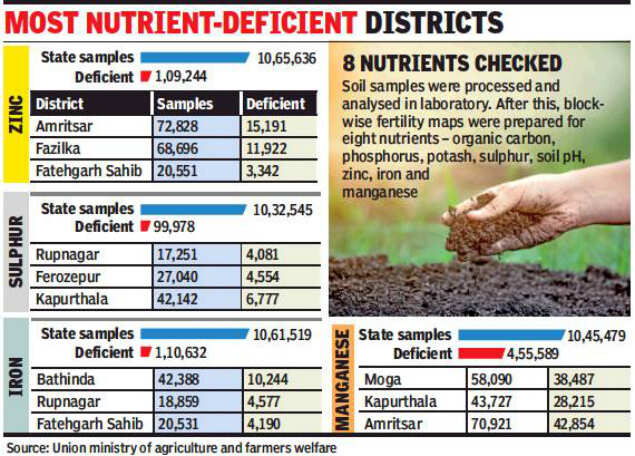
CHANDIGARH: To improve soil nutrition and crop production, the Punjab government has prepared a soil-fertility map, highlighting nutrient deficiency of each agricultural landholding in the state.
By doing so, Punjab has become the first state in the country to prepare a soil-fertility map of the landholding of each farmer by using global positioning system (GPS) and geographical information system (GIS). This, hopes the state government, will generate awareness among farmers about the judicious use of chemical fertilizers based on soil health status of their land. Earlier, soil fertility maps were only available at district level.

The department of agriculture gathered soil samples of about 17 lakh landholdings in 150 blocks covering 12,581 villages across the state. These samples were processed and analysed in laboratory. Based on this, block-wise fertility maps have been prepared for eight nutrients – organic carbon, phosphorus, potash, sulphur, soil pH, zinc, iron and manganese.
The presence of nutrients is rated as low, medium and high. Red colour has been used to show low nutrient level, green for high and yellow for normal. Each map contains recommendation and remedial measures which the farmers need to take to overcome the deficiency.
Punjab secretary (agriculture) K S Pannu said the department had mapped each field and launched a campaign in all districts to sensitize farmers about the health of their soil. Under the campaign, fertility maps have been put at multiple locations in each village. “So far, more than 3,500 villages have been covered and the department aims to cover all villages before sowing of paddy starts, so that farmers can judiciously use chemical fertilizers on the basis of soil health and status of farm land,” said Pannu.
Over and unscientific use of nitrogen, phosphorous and potassium fertilizers has impacted the nutrient values of soil, hitting the state’s crop production.
As per the soil health dashboard of the ministry of agriculture and farmers welfare, there is deficiency is different nutrients across the state.
Of the total 10,65,636 samples analysed across the state, 1,09,244 were found deficient in zinc. In Amritsar, 15,191 samples of 72,828 were deficient in zinc, followed by Fazilka, where 11,922 of 68,696 samples failed to meet the minimum standard.
Similarly, 99,978 samples out of 10,32,545 had low level of Sulphur in Fazilka. Ropar topped the list with 4,083 samples having Sulphur deficiency out of 17,251 samples examined. In Ferozepur, 4,554 out of 27,040 samples had low level of sulphur.
By doing so, Punjab has become the first state in the country to prepare a soil-fertility map of the landholding of each farmer by using global positioning system (GPS) and geographical information system (GIS). This, hopes the state government, will generate awareness among farmers about the judicious use of chemical fertilizers based on soil health status of their land. Earlier, soil fertility maps were only available at district level.

The department of agriculture gathered soil samples of about 17 lakh landholdings in 150 blocks covering 12,581 villages across the state. These samples were processed and analysed in laboratory. Based on this, block-wise fertility maps have been prepared for eight nutrients – organic carbon, phosphorus, potash, sulphur, soil pH, zinc, iron and manganese.
The presence of nutrients is rated as low, medium and high. Red colour has been used to show low nutrient level, green for high and yellow for normal. Each map contains recommendation and remedial measures which the farmers need to take to overcome the deficiency.
Punjab secretary (agriculture) K S Pannu said the department had mapped each field and launched a campaign in all districts to sensitize farmers about the health of their soil. Under the campaign, fertility maps have been put at multiple locations in each village. “So far, more than 3,500 villages have been covered and the department aims to cover all villages before sowing of paddy starts, so that farmers can judiciously use chemical fertilizers on the basis of soil health and status of farm land,” said Pannu.
Over and unscientific use of nitrogen, phosphorous and potassium fertilizers has impacted the nutrient values of soil, hitting the state’s crop production.
As per the soil health dashboard of the ministry of agriculture and farmers welfare, there is deficiency is different nutrients across the state.
Of the total 10,65,636 samples analysed across the state, 1,09,244 were found deficient in zinc. In Amritsar, 15,191 samples of 72,828 were deficient in zinc, followed by Fazilka, where 11,922 of 68,696 samples failed to meet the minimum standard.
Similarly, 99,978 samples out of 10,32,545 had low level of Sulphur in Fazilka. Ropar topped the list with 4,083 samples having Sulphur deficiency out of 17,251 samples examined. In Ferozepur, 4,554 out of 27,040 samples had low level of sulphur.
Elections 2019
Trending Topics
More from TOI
Navbharat Times
Featured Today in Travel
Quick Links
Lok Sabha Election Schedule 2019Lok Sabha Election NewsDelhi Capitals teamMI team 2019Rajasthan Royals 2019RCB team 2019Maharashtra Lok Sabha ConstituenciesBJP Candidate ListBJP List 2019 TamilnaduShiv Sena List 2019AP BJP List 2019Mamata BanerjeeBJP List 2019 MaharashtraPriyanka GandhiBJP List 2019 KarnatakaAMMK Candidate List 2019BJP List 2019 WBLok Sabha Elections in Tamil NaduBSP List 2019 UPNews in TamilLok Sabha Poll 2019Satta Matka 2018PM ModiMahagathbandhanNagpur BJP Candidate ListChandrababu NaiduTamil Nadu ElectionsUrmila MatondkarNews in TeluguMadras High CourtTejashwi YadavArvind KejriwalTejasvi SuryaPawan KalyanArvind KejriwalYogi AdityanathJaya PradaSatta King 2019Srinagar encounter
Get the app









